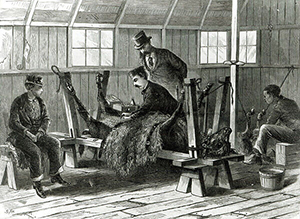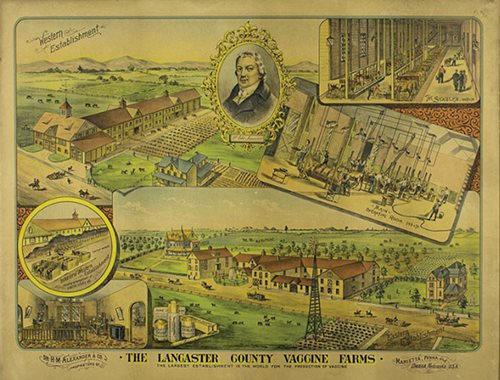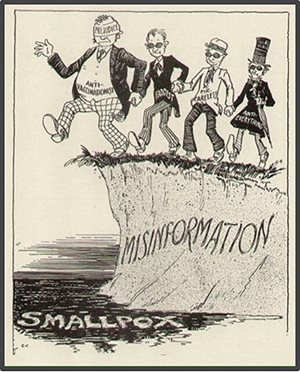Spring 2023 - Vol. 18, No. 1
SCIENTIFIC REPORT
Armed and Ready
How Lancaster County Contributed to the Eradication of Smallpox
Meagan A. Schulman
Collections Coordinator and Research Librarian
Lancaster Medical Heritage Museum
In 1980, the World Health Organization declared smallpox eradicated, an accomplishment that has long been hailed as one of humanity’s greatest achievements. Although the origin of smallpox remains unknown, its effect on the world until that time was devastating.
1 Infection could mean pain, scarring, and a high risk of death, and this scourge had ravaged the Americas since the arrival of European immigrants.
Vaccines have made it possible for us to forget a time when a smallpox epidemic was so feared. While many narratives have been dedicated to praising Dr. Edward Jenner’s work in 1796, remarkably few have discussed the details of vaccine dissemination. Credit for the latter is owed in large measure to the work of Dr. H.M. Alexander of Marietta, who in 1882 founded what came to be known as the Marietta — or variously, Lancaster County — Vaccine Farm. It was there that he and his colleagues produced and supplied the country, and indeed, much of the world, with smallpox vaccine.
2 The success of the Lancaster County Vaccine Farm at producing and distributing vaccine shaped Pennsylvania’s and the nation’s ability to ultimately eradicate smallpox.
3,4
INOCULATION VS. VACCINATION
From 1721 to 1796 the only preventive measure available against smallpox was inoculation. Simply put, inoculation was taking pus from a patient who had been infected with smallpox and creating an incision in a healthy individual into which one could place the pox matter. This action created an immune response that, it was hoped, would be less severe and less deadly than getting smallpox in what was called the “natural” way. Unfortunately, inoculated individuals were themselves contagious, meaning that this practice left a community one individual away from initiating another epidemic.
5 Vaccination is a much safer practice.
Credit for developing vaccination is given to Dr. Edward Jenner, who in 1796 used cowpox to stimulate an immune response that afforded protection against smallpox. This followed the observation that milkmaids with a history of cowpox infection were often spared the horrors of smallpox. Thus, the term vaccination was born:
vacca is cow in Latin.
The concept is largely preserved today, when vaccination often entails injecting an inactive form of virus to induce immune response. However, it must be noted that Jenner’s initial form of vaccination was not achieved as it is today. The cowpox used in Jenner’s vaccines were not “an attenuated or inactivated form” of the smallpox virus; rather “it was [a] related virus from the same famil[y].”
6 Even though vaccination was a safer alternative to inoculation, it took nearly a century for acceptance of vaccination to become widespread in America, in part due to logistical nightmares that caused massive pushback movements.
4
Once vaccination achieved a measure of success in America, inoculation was made illegal. Reducing the use of inoculation (arm-to-arm) meant also reducing the inadvertent spread of other diseases such as syphilis.
7,8 At least as important, eliminating the common use of this outdated method also limited the risk for further epidemics, ones that could be ignited by well-meaning medical personnel who traveled from city to city.
ORIGINS
Born of the mind of Dr. H.M. Alexander, the Lancaster County Vaccine Farm started in 1882 with just one cow. It remains unclear how he harvested his initial vaccine matter. The first heifer at the vaccine farm was thought to have had spontaneous cowpox,
2,3,9 although Alexander may have inoculated a calf from a local patient’s smallpox pustules. Yet another report suggests a “tramp having smallpox” had slept in the stable.
10 Nevertheless, only a year later it became necessary to expand the farm to include 500 calves, so successful was his enterprise.
11

 Taking virus from the calf, illustration from Harper’s Weekly, 1872 Dr. H.M Alexander
Taking virus from the calf, illustration from Harper’s Weekly, 1872 Dr. H.M Alexander
(engraving) (b/w photo) by Fox, Stanley (fl. 1872); American, out of
copyright.
An
obstacle Alexander aimed to address was finding alternatives to using arm-to-arm vaccination. Arm-to-arm vaccination was a logistical nightmare, but even after vaccination became a primary preventive measure, doctors continued using this outdated method. Called the “human-chain,” the transmission of vaccination in this way would fail if either “the timing was off or the vaccine failed to take in one person of the sequence.”
12 Thus, it was with the introduction of standardized techniques and procedures, including the development of glycerinated points, that vaccine production could overcome the limitations of inoculation — including the spread of diseases such as syphilis. Alexander studied methods, improved upon them, and ultimately commercialized his ideas. His world renown at the time was a testament to the success of his achievements.
8
To assure the safety of vaccination, Alexander made certain that all the calves that came to the farm were “graded” and had “a complete family history.”
13 A standardization measure such as this was unprecedented — when scientists were on the cusp of understanding germ theory — and yet Alexander knew of and responded to the earliest criticisms that could face his enterprise by keeping strict records. By 1884, only two years after initiation of the farm, a wagon was added to transport calves, avoiding unnecessary risk for the owners as well as the cows themselves.
14
Alexander was an innovator and pioneer. While others hypothesized that alternative protocols would produce safer results, Alexander enforced a standard of mixing the retrieved lymph with 40% to 60% glycerol and storing glycerinated lymph at low temperatures to kill off remaining bacteria. Glycerin had many advantages, including antibacterial properties; further, it prevented ice buildup and allowed the vaccine to “stick to the skin.”
8

 Among the many historical medical items housed in the National Collections of the Smithsonian are Dr. H.M. Alexander’s aseptic vaccinator (left) and an original glycerinated smallpox vaccine lymph (right). Photos from the Smithsonian National Collections, available online at si.edu/collections.
GROWTH
Among the many historical medical items housed in the National Collections of the Smithsonian are Dr. H.M. Alexander’s aseptic vaccinator (left) and an original glycerinated smallpox vaccine lymph (right). Photos from the Smithsonian National Collections, available online at si.edu/collections.
GROWTH
A decade later, the Lancaster County Vaccine Farm, known to be the largest of its kind in the world, produced the most vaccine “lymph” in the nation — equaling 100,000 doses per day.
1,11,15 Thus, in May 1902, when Lancaster itself faced a smallpox epidemic, rules were created that included the role of the farm in stabilizing the community and preventing spread. After establishment of a quarantine and a ban on meetings in any public locations, the Board of Health approved “ordering compulsory vaccination” and employed “patrolmen for the infected districts.” In the event of noncompliance, the county had the authority to “prosecute all persons guilty of violating the quarantine laws,” and infected individuals could be stipulated to specific smallpox hospitals.
2 This public health plan would not have been possible without the doses from Alexander’s farm.
Soon the Lancaster County Vaccine Farm gained the confidence of those across the nation. During the 1894 “business depression,” the farm was more profitable than ever; for a time the city of Chicago was placing an order for 10,000 points
per day.16 While Alexander’s was not the only vaccine farm operating in this era, none were as illustrious or as trusted as the one in Marietta,
12 and it soon outgrew its location. Alexander added another farm in Northumberland County,
2 as well as one in Omaha, Nebraska.
17 News reports favored Alexander for remaining the largest and one of the most successful suppliers of smallpox vaccine in the United States and the world.
3

This undated color lithograph of the plan of the Lancaster County Vaccine Farms notes
locations in Marietta, Northumberland County, and Omaha, Nebraska.
VALIDATION
Although the Lancaster County Vaccine Farm was a household name, questions regarding the safety of vaccine lymph did threaten to dismantle this and all operations. It was not until 1902 that Congress passed the Biologics Control Act, which obligated businesses selling biological products to apply for and maintain licensing.
12 This legislation worked to Alexander’s advantage, as it differentiated his operation, which already had safety mechanisms in place, from so-called “backyard producers.”
8 The Lancaster County Vaccine Farm continued to add protocols, including measures to ensure the animals were “well fed and well groomed,” as well as quarantined for a month before they were inoculated. In terms of the facilities themselves, the reports from the time state it followed “strict aseptic and antiseptic precautions … as in any modern hospital.”
18 When inoculation of the animal began, the Lancaster farm personnel specifically selected samples from the inner thigh, an area less likely to become secondarily infected after the procedure.
19
Further protocols regarded how the vaccine lymph was stored. As noted, the fact that Alexander’s glycerinated lymph was stored at low temperature had many advantages.
8 Thus, his vaccine had a good “reputation for purity.”
3 This was backed up by views from the Philadelphia Board of Medicine, which declared only the Lancaster County Vaccine Farm’s vaccine was “entirely free from pus bacteria,” saprophytic bacteria, and blood cells.
20
In 1893, Alexander took his idea to the World’s Fair in Chicago, where he was the recipient of the only “award on vaccine virus.”
9,21-24 Three years later, the Lancaster County Vaccine Farm was selected to host the centennial celebration for the development of Jenner’s vaccination process.
25,26 Not only was this an extravagant event meant to celebrate the accomplishments of Edward Jenner, but the choice of location exemplified H.M. Alexander’s success and demonstrated that his was the model for vaccine farm production. It was soon described as “by far the largest and most complete [laboratory] in the world.”
27
DISSEMINATION
By 1903, the Marietta farm was producing “more [vaccine] virus than all similar establishments in the United States combined.”
21 Further, publications from that time were overwhelmingly positive, frequently touting the purity of Lancaster’s lymph. A Minneapolis Journal headline from 1883 described “Absolutely pure vaccine virus: from the Marietta [farms].”
28 Years later, a newspaper in the state of Washington urged parents to have confidence because the “supply points come from the government vaccine farm at Marietta, Pa., and every possible precaution is being used.”
29 Indeed, this sentiment became common; vaccines from Marietta were considered superior to any others.
Alexander was also a shrewd negotiator of public opinion. In a 1901 advertisement in the
New York Medical Journal, he stated: “In small-pox vaccination the greatest number of definite protective inoculations [have] followed the use of our lymph … it is surely better than to follow blindly in the trail of a dangerous foreign fad.”
30 Such comments served multiple purposes. First, if someone in the community had a bad experience after vaccination from a so-called “backyard” producer, devastating community-wide consequences could ensue as peers lost faith in the entire practice.

1930s cartoon
On the other hand, by explicitly explaining the practice and regularly inviting others to examine his processes, Alexander helped eliminate mystery from the lay mind, making others more likely to seek preventive treatment. Newspapers and the medical community took notice, agreeing that “few know of … the many precautions used to ensure the obtaining of the virus [is] physiologically pure.” Similar accounts could be found across the nation, proclaiming the Lancaster vaccine’s purity as a justification for encouraging vaccination.
13,21,31-34 Orders eventually came in from countries around the world, and Lancaster’s shipments were sent far and wide, to Canada and Mexico, to China, as well as countries in South America and Europe.
30
CONCLUSION
The Lancaster County Vaccine Farm paved the way for modern medicine in the United States. It was beyond its years in biological products regulation and vaccine standards. What started out as one man and a calf had a profound and lasting impact on the lives of millions of people across the globe. Smallpox was a dreaded disease, and while society owes a great debt to the innovations of Dr. Edward Jenner, Dr. H.M. Alexander and the Lancaster County Vaccine Farm surely deserve their share of recognition and appreciation for the strides they made in Marietta.
REFERENCES
1. Safekeeping stockpile of smallpox stored in Marietta.
The Intelligencer Journal. July 16, 1999.
2. Lahr JW.
Hale Columbia: A True and Complete Study of Infectious Disease & Medicine in a Small Pennsylvania Town at the Turn of the Century. 2017.
3. Chapman Publishing Company.
Portrait and Biographical Record of Lancaster County, Pennsylvania: Containing Biographical Sketches of Prominent and Representative Citizens ... Together with Biographies and Portraits of All the Presidents of the United States. Chapman; 1894:597. Accessed July 7, 2022.
http://archive.org/details/portraitbiograph00inchap
4. Reinert J. Here’s how a farm in Marietta became a global vaccine production site.
LNP. July 1, 2020. Accessed June 12, 2022.
https://www.proquest.com/docview/2419347481/citation/2CB7A250A0D D4C6APQ/1
5. For more on inoculation in colonial America, see: Fenn EA.
Pox Americana: The Great Smallpox Epidemic of 1775-82. Sutton; 2004.
6. Esparza J, Nitsche A, Damaso CR. Beyond the myths: novel findings for old paradigms in the history of the smallpox vaccine.
PLoS Pathogens. 2018;14(7):e1007082.1.
7. Marquez M. Animal vaccine — why it should be preferred to human vaccine.
Public Health Papers and Reports. 1893;84.
8. Didgeon J. Development of smallpox vaccine in England in the eighteenth and nineteenth centuries.
Br Med J. 1963;1(5342):1367-1372.
9. The Inquirer. October 21, 1893.
10. Theocrat. December 5, 1914.
11. Lancaster City and County Medical Society.
Our Medical Heritage 1844-1994: Lancaster City and County Medical Society. 1st ed. Lancaster City and County Medical Society;1995:140.
12. History of the Smallpox Vaccine. Indiana University Bloomington. Accessed October 31, 2022.
https://collections.libraries.indiana.edu/iulibraries/s/smallpox-vaccine-exhibit/page/welcome
13. Reilly RF. Medical and surgical care during the American Civil War, 1861-1865.
Proc (Bayl Univ Med Cent). 2016;29(2):138-142.
14. Lancaster New Era. October 4, 1884.
15. Sunday News. March 2, 1930.
16. The Semi-Weekly New Era. May 12, 1894.
17. Philadelphia Inquirer. October 15, 1903.
18. The Medical and Surgical Reporter 1896-10-17:Vol 75 Iss 16. Open Court;1896:489. Accessed January 30, 2023.
http://archive.org/details/sim_medical-and-surgical-reporter_1896-10-17_75_16
19. Eleventh annual report of the board of managers of the Columbia Hospital at Columbia, Lancaster County, Pennsylvania.
The Columbia Herald Print. 1906:311.
20. Tenth annual report of the board of managers of the Columbia Hospital at Columbia, Lancaster County, Pennsylvania.
The Columbia Herald Print. 1906:254-255.
21. Lancaster New Era. October 14, 1903. Virus is how the vaccine would be referenced in the newspaper ads at this time.
22. The Lancaster Examiner. June 10, 1893.
23. Akron Daily Democrat. December 1, 1892.
24. Tyrone Daily Herald. December 1, 1892.
25. The Semi-Weekly New Era. May 27, 1896.
26. The Buffalo Sunday Morning News. May 17, 1896.
27. The News-Journal. May 21, 1898.
28. The Minneapolis Journal. February 8, 1883.
29. The Tacoma Daily Ledger. July 26, 1892.
30. Pamphlets — homoeopathic: vaccination.
Compulsory Medicine. 1907:3.
31. The San Francisco Examiner. October 18, 1899.
32. The Yonkers Herald. May 19, 1898.
33. The North Adams Transcript. May 6, 1898.
34. The Commercial Appeal. February 18, 1899.